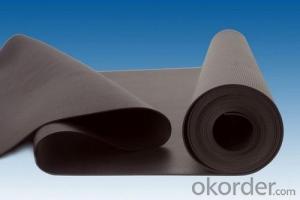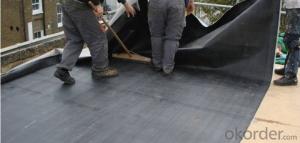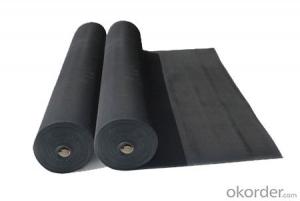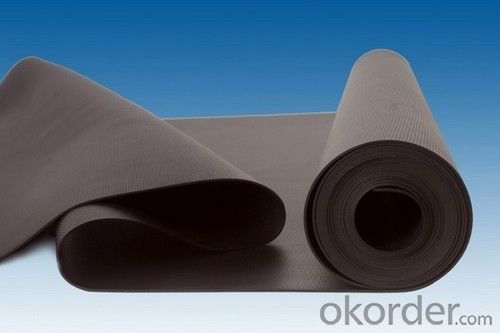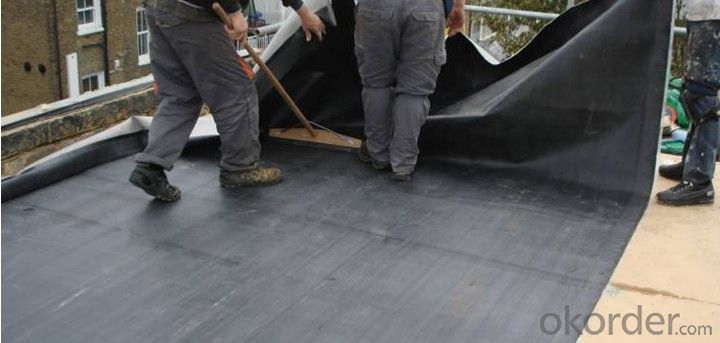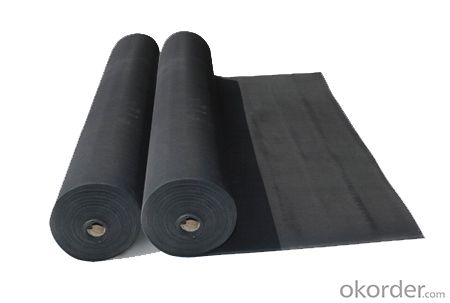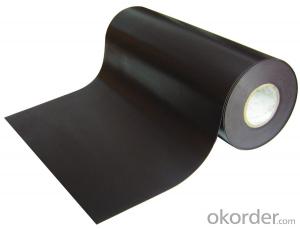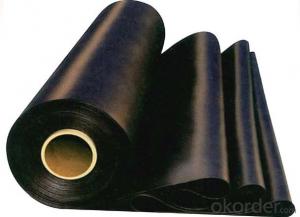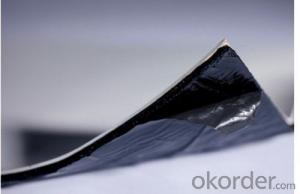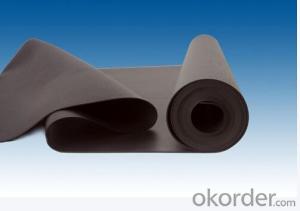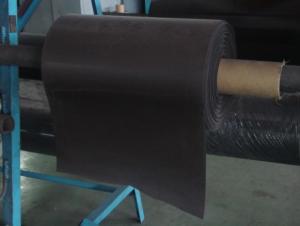EPDM Waterproofing Membrane for Underground Roof
- Loading Port:
- China main port
- Payment Terms:
- TT OR LC
- Min Order Qty:
- 5000 m²
- Supply Capability:
- 100000 m²/month
OKorder Service Pledge
OKorder Financial Service
You Might Also Like
Introduction for EPDM Waterproofing Membrane:
This waterproof coiled material is of high elasticity with best performance among high polymer waterproof coiled material in the world.It is also the most typical one in the world.Waterproof coiled material made of ternary ethylene-propylene rubber is produced with the use of the most advanced continuous extrusion and vulcanization technology and related equipments which are specially designed for production of such product.It is good in compactness,without bubble and performance difference in length and breadth,performances reach or exceed the demands.
Characteristic of EPDM Waterproofing Membrane:
1>Excellent anti-aging performance, service life up to 50 years
2>Working well with in -40°C to 100°C,it can be constructed with a single layer in ambient temperature. 3>Waterproofing on various kinds of underground project,industrial of civil buildings and structures. 4>high extension rate, high tensile strength, small size changes at heat treatment
5>Good plant roots penetrability resistance and can be made waterproofing layer of planting roof
6>Special modified molecular structure ,effectively resolving the current domestic and foreign glue joint problem . 7>Good low temperature flexibility, and good performance of adapting to ambient temperature changes. 8>Convenient application ,solid joint, no environment pollution
9>chemical corrosion Resistance, can be used for special occasions
Usesage of EPDM Waterproofing Membrane:
Widely used in roofs, basement, toilet ,swimming pool, and all kinds of industry and civil building waterproofing, reservoir, bridge, underground, tunnel and dam waterproofing ,especially to the keystone waterproofing projects which is durability, high corrosion resistance and easy deformation
Item | Thickness(mm) | Width(mm) | Length(m) | Color |
1.0—2.0 | 1200 | 20 | Black | |
Deviation | -1 +15 | --1 | Multicolor |
FAQ of Waterproofing Membrane
a.Can we get some samples before place order?
Answer: We can send the free samples to you by freight collect.
b.How many years can your PVC membrane guarantee?
Answer: We will guarantee the quality for 5 years at least.
c.Which countries you ever export the product?
Answer: We export the PVC membrane to South Africa, Middle east and even European countries.
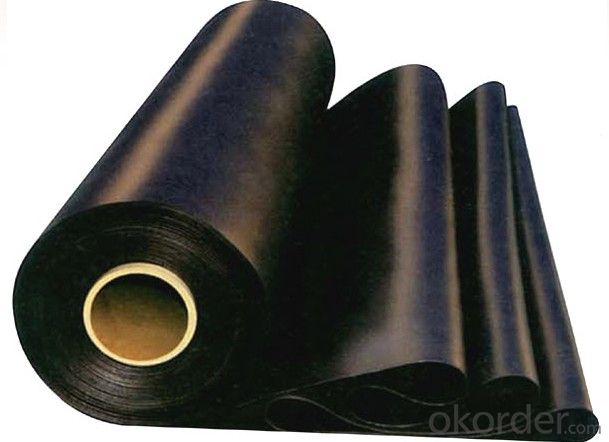
- Q: Are waterproofing membranes resistant to high-pressure water jets?
- Yes, waterproofing membranes are designed to be resistant to high-pressure water jets. These membranes are specifically engineered to withstand the force and intensity of high-pressure water, ensuring effective protection against water infiltration.
- Q: Can a waterproofing membrane be used for temporary structures or tents?
- Yes, a waterproofing membrane can be used for temporary structures or tents. Waterproofing membranes are designed to provide a protective barrier against water, preventing it from penetrating the surface and causing damage. This makes them an ideal choice for temporary structures or tents, as they can effectively keep the interior dry during rain or other wet conditions. Additionally, waterproofing membranes are often lightweight and flexible, making them easy to install and remove, which is especially beneficial for temporary structures or tents that may need to be relocated or dismantled.
- Q: Can a waterproofing membrane be used in conjunction with concrete repair or restoration?
- Yes, a waterproofing membrane can be used in conjunction with concrete repair or restoration. In fact, it is often recommended to use a waterproofing membrane as a protective layer over repaired or restored concrete surfaces. This is because concrete repair or restoration may involve the removal of damaged or deteriorated areas, which can compromise the waterproofing properties of the original concrete. By applying a waterproofing membrane, you can ensure that the repaired or restored concrete remains protected against water intrusion, which can lead to further damage and deterioration. Additionally, the waterproofing membrane can also help to enhance the overall durability and longevity of the concrete structure.
- Q: Does a waterproofing membrane require any special considerations for installation in seismic zones?
- Yes, a waterproofing membrane does require special considerations for installation in seismic zones. Seismic zones are prone to earthquakes and ground movements, which can cause significant stress and strain on the building structure. When installing a waterproofing membrane in such areas, it is crucial to ensure that it can withstand the potential movements and vibrations caused by seismic activities. Some of the special considerations for installing a waterproofing membrane in seismic zones include: 1. Flexibility: The membrane should have sufficient flexibility to accommodate the movement of the building structure during an earthquake. It should be able to stretch, contract, and withstand dynamic forces without tearing or losing its waterproofing properties. 2. Compatibility: The waterproofing membrane should be compatible with the building materials and systems used in seismic zones. It is important to select a membrane that can bond well with the substrate and other construction components to create a seamless and robust waterproofing system. 3. Reinforcement: In high seismic areas, it is recommended to reinforce the waterproofing membrane with additional layers or reinforcements. This can be done by adding a fabric or mesh layer to enhance the membrane's tensile strength and resistance to tearing caused by seismic movements. 4. Proper installation techniques: The installation of the waterproofing membrane in seismic zones should follow specific guidelines and techniques to ensure its effectiveness. It may involve using specific adhesives, primers, or mechanical fastening systems to secure the membrane properly. 5. Quality control: Regular inspections and quality control measures should be implemented during and after the installation process. This helps to identify any potential issues or deficiencies in the waterproofing system, allowing for prompt repairs or adjustments to be made. By addressing these special considerations, the installation of a waterproofing membrane in seismic zones can help protect the building structure from water intrusion and potential damage caused by earthquakes. Consulting with experienced professionals and following industry standards and guidelines is crucial to ensure a successful installation in these challenging environments.
- Q: Can a waterproofing membrane be used in boat decks or marinas?
- A waterproofing membrane is capable of being used in boat decks or marinas. Boat decks and marinas are subjected to constant water exposure, which makes them vulnerable to deterioration and damage over time. To protect these surfaces from water intrusion, a waterproofing membrane offers an effective solution. This prevents issues like rotting, warping, and the growth of mold. Acting as a barrier, the membrane prevents water from seeping into the underlying structure and causing harm. Moreover, it helps maintain the structural integrity of boat decks or marinas, thus extending their lifespan. Furthermore, the use of a waterproofing membrane enhances safety by reducing the risk of slip and fall accidents through the provision of a slip-resistant surface. All in all, opting for a waterproofing membrane for boat decks or marinas is a smart decision to ensure durability, longevity, and safety.
- Q: Can a waterproofing membrane be used in conjunction with a drainage system?
- Yes, a waterproofing membrane can be used in conjunction with a drainage system. In fact, it is often recommended to use both together for effective waterproofing and drainage in areas such as basements, roofs, and foundations. The waterproofing membrane acts as a barrier to prevent water from seeping through the surface, while the drainage system helps to remove any excess water that may accumulate. By combining these two systems, it ensures a comprehensive solution to protect the structure from potential water damage.
- Q: Can a waterproofing membrane be used for residential swimming pools?
- Indeed, residential swimming pools can benefit from the use of a waterproofing membrane. These membranes are frequently employed in construction to safeguard against water infiltration and can be utilized on diverse surfaces including concrete, tile, and metal. By forming a barrier, they effectively prevent water from permeating the pool structure, thereby preserving its integrity and averting leaks. Furthermore, waterproofing membranes afford protection against other types of harm such as corrosion and deterioration resulting from chemicals or adverse weather conditions. Consequently, it is crucial to choose a top-notch waterproofing membrane specifically designed for swimming pool applications in order to guarantee long-lasting safeguarding and durability.
- Q: Are waterproofing membranes easy to install?
- Yes, waterproofing membranes are generally easy to install. They come in various forms such as sheets, rolls, or liquid coatings, making them adaptable to different surfaces and applications. The installation process typically involves cleaning and preparing the surface, applying the membrane, and ensuring a proper seal. While some technical knowledge and tools may be required, manufacturers often provide detailed instructions and guidelines for installation, making it easier for both professionals and DIY enthusiasts. Additionally, advancements in technology have led to the development of self-adhesive membranes, which further simplify the installation process. Overall, with the right preparation and following the correct installation procedures, waterproofing membranes can be installed with relative ease.
- Q: Are there different waterproofing membrane options for above-ground and below-ground applications?
- Yes, there are different waterproofing membrane options available for above-ground and below-ground applications. Above-ground applications typically involve waterproofing structures such as roofs, balconies, or walls. For these applications, commonly used waterproofing membrane options include liquid-applied membranes, sheet membranes, and polyurethane membranes. These membranes are designed to withstand exposure to weather elements such as UV rays, temperature changes, and foot traffic. On the other hand, below-ground applications involve waterproofing structures like basements, foundations, or tunnels. Below-ground waterproofing membranes are specifically designed to withstand hydrostatic pressure from the surrounding soil and groundwater. These membranes are typically thicker and more durable than above-ground membranes. Commonly used below-ground waterproofing options include bituminous membranes, bentonite clay membranes, and composite membranes. It is important to choose the right waterproofing membrane for each specific application as the requirements and challenges can vary. Consulting with a waterproofing professional or engineer can help determine the most suitable membrane option for both above-ground and below-ground applications.
- Q: Can a waterproofing membrane be used on concrete walls?
- Yes, a waterproofing membrane can be used on concrete walls. Waterproofing membranes are commonly used to protect concrete walls from water infiltration and can effectively prevent moisture from seeping through the concrete surface.
Send your message to us
EPDM Waterproofing Membrane for Underground Roof
- Loading Port:
- China main port
- Payment Terms:
- TT OR LC
- Min Order Qty:
- 5000 m²
- Supply Capability:
- 100000 m²/month
OKorder Service Pledge
OKorder Financial Service
Similar products
Hot products
Hot Searches
Related keywords
